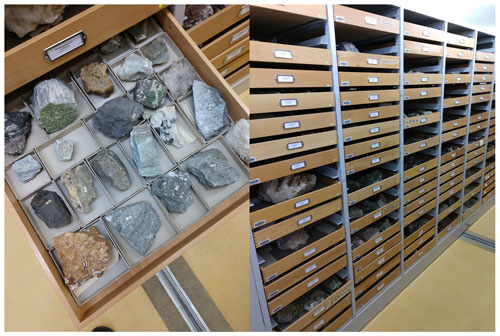Brugnatelli, S. C. L.: Sopra un nuovo minerale delle cave d'Amianto della Valle
Lanterna, Rendiconti Reale Istituto Lombardo di Scienze e Lettere (Milano),
35, 869–874, 1902.
Brush, G. and Dana, E.: On a new and remarkable mineral locality in Fairfield
County, Connecticut; with a description of several new species occurring
there, American Journal of Science and Arts, 116, 33–46, 114–123, 1878.
Cámara, F., Oberti, R., Chopin, C., and Medenbach, O.: The arrojadite
enigma I. A new formula and a new model for the arrojadite structure, Am.
Mineral., 91, 1249–1259, 2006.
Chopin, C., Oberti, R., and Cámara, F.: The arrojadite enigma II.
Compositional space, new members, and nomenclature of the group, Am.
Mineral., 91, 1260–1270, 2006.
Costa, A.: Ricordo di Pietro Sigismund: le sue Collezioni mineralogiche,
Periodici dell'Istituto Valtellinese di Mineralogia, 1, 4–6, 2008.
Demartin, F., Gramaccioli, C. M., Pilati, T., and Sciesa, E.: Sigismundite,
(Ba,K,Pb)Na3(Ca,Sr)(Fe,Mg,Mn)14(OH)2(PO4)12, a new
Ba-rich member of the arrojadite group from Spluga valley, Italy, Can.
Miner., 34, 827–834, 1996.
Gramaccioli, C. M.: I minerali Valtellinesi nella raccolta di Pietro
Sigismund, Milano, 179 pp., https://www.worldcat.org/title/minerali-valtellinesi-nella-raccolta-di-pietro-sigismund/oclc/602645069 (last access: 20 March 2022), 1962.
Guimarães, D.: Arrojadita, um novo mineral do grupo da wagnerita,
Publicaçao da Inspectoria de Obras Contra as Seccas, Rio de Janeiro, 58,
119–122, 1925.
Hatert, F., Mills, S., Pasero, M., and Williams, P.: CNMNC guidelines for
the use of suffixes and prefixes in mineral nomenclature, and for the
preservation of historical names, Eur. J. Mineral., 25, 113–115, 2013.
Huminicki, D. and Hawthorne, F.: The crystal chemistry of the phosphate
minerals, in: Phosphates:
geochemical, geobiological, and materials importance, edited by: Kohn, M., Rakovan, J., and Hughes, J., Vol. 48, 123–254, Reviews
in Mineralogy and Geochemistry, Mineralogical Society of America, Chantilly,
Virginia, https://doi.org/10.2138/rmg.2002.48.5, 2002.
Kampf, A. R., Alves, P., Kasatkin, A., and Škoda, R.: Jahnsite-(MnMnZn),
a new jahnsite-group mineral, and formal approval of the jahnsite group,
Eur. J. Mineral., 31, 167–172, 2019.
Lykova, I., Rowe, R., Poirier, G., Helwig, K., and Friis, H.:
Manganoarrojadite-(KNa),
KNa5MnFe13Al(PO4)11(PO3OH)(OH)2, a new
arrojadite-group mineral from the Palermo No.1 mine, New Hampshire, USA,
Miner. Mag., 84, 932–940, 2020.
Miyawaki, R., Hatert, F., Pasero, M., and Mills, S. J.: Newsletter 66,
Miner. Mag., 86, 1–4, https://doi.org/10.1180/mgm.2022.33, 2022.
Revheim, O. and King, V.: Epidote supergroup nomenclature: The names
hancockite, niigataite and tweddillite reinstated, Miner. Mag., 80, 877–880,
2016.
Warr, L. N.: IMA–CNMNC approved mineral symbols, Miner. Mag., 85, 291–320,
2021.






